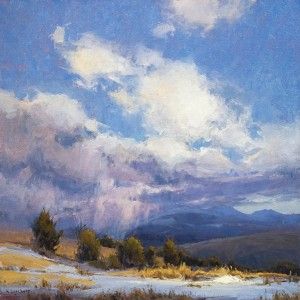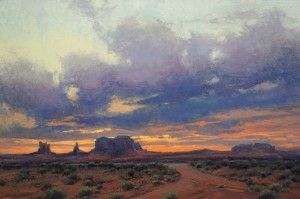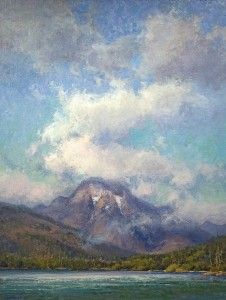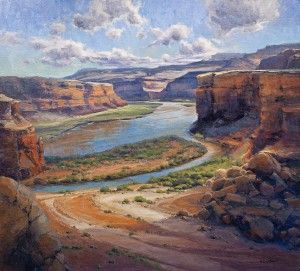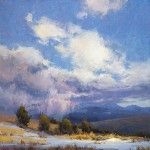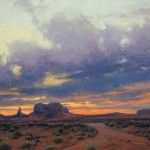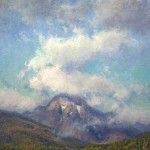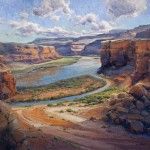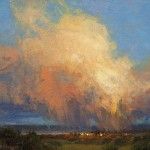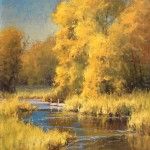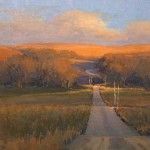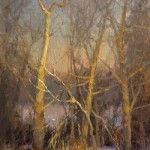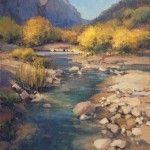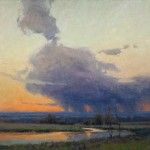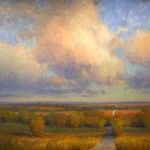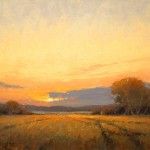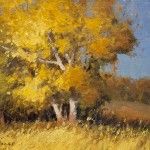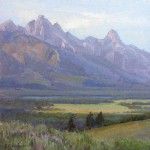Kim Casebeer explores the landscape from all angles
By Elizabeth L. Delaney
This story was featured in the June 2015 issue of Southwest Art magazine. Get the Southwest Art June 2015 print issue or digital download now–then subscribe to Southwest Art and never miss another story!
AT HER CORE, Kim Casebeer is an explorer. Always seeking out new and engaging lands, she situates herself within broad panoramas and quaint vistas, absorbing the distinctive traits and temperaments of each place. Then, she paints. Transforming three-dimensional experiences into two-dimensional space, Casebeer records, interprets, and finally shares her findings with others. During this process, she becomes intimately acquainted with her subject matter from all angles: aesthetic, intellectual, and personal. “The ties that I have to the land are ones that I feel deeply,” she says. “I can’t paint a subject if I’m not emotionally attached. It’s the attachment, the emotion, that needs to end up on the canvas. I’ve learned I have to spend time at a particular place before that happens. It may take several trips, but it’s when I feel comfortable in a place that my best work comes out.”
Casebeer’s vivid landscapes depict the innate beauty found in both expected and unexpected locations across her home state of Kansas and throughout the American West. As they capture each region’s signature terrain and light effects, her paintings also reveal the artist’s deep and abiding awe for nature. But more than that, they serve to encapsulate her lifelong pursuit to define her place within the land, and also to nurture her physical and emotional bonds with it. Further, Casebeer’s nature-inspired narratives invite viewers to come along on her journey, to slow down a while and savor the dynamic, living space she has created within the boundaries of the picture plane.
RAISED ON a farm in rural Kansas, Casebeer spent a lot of time exploring the boundless spaces surrounding her home. This constant investigation and discovery allowed her to cultivate an enduring love for the land. “I grew up enjoying the outdoors from the very beginning,” she says, reflecting on her life as a country kid enamored by the rolling hills, limitless skies, and open prairie that characterize the Flint Hills. Of her native land, she says, “It’s a simple landscape. It’s not grandiose. You have to spend some time and let it speak to you.”
As an adult, Casebeer remains drawn to the freedom and fulfillment that come from the thrill of discovery. She still finds subject matter close to her Kansas home, but nowadays, she has expanded her horizons to encompass the western half of the country. “I think the simplicity of the Kansas landscape has helped me find the essence of other places,” she says. “I’m able to focus on what’s important in a composition.” Recent explorations include trips to Canyonlands National Park in Utah, Colorado’s Monument Valley, Wyoming, and California. Casebeer is continually enthralled by the austerity of such areas, inspired by their vastness and purity.
Descended from multiple generations of farmers, Casebeer was the first in her family to take an interest in art. Though her father and grandfather dabbled in craftwork such as clock making, the principal creative influence throughout her childhood and youth was her art teacher. (She had the same one from elementary through high school.) Yet despite her early art education and growing affection for painting and drawing, she never considered fine art as a viable career path. By the time Casebeer enrolled at Kansas State University, she had decided to explore more commercial avenues, first experimenting with interior design and then settling on graphic design as her major.
After earning her bachelor of fine arts, Casebeer went to work in advertising, continuing to make her own art on the side. She continued this path for nearly a decade until her desk job became too stifling, and in 2002, she transitioned into painting full time. She began showing her work at a local artists’ guild, and soon after that she joined a commercial gallery. From there her career blossomed, and today she is represented by six galleries, participates in numerous national exhibitions, has been featured in many publications, and shares her love of painting the outdoors by teaching plein-air workshops. Casebeer has continued her own education as well, studying with such artists as Albert Handell, W. Scott Jennings, Michael Albrechtsen, Scott Christensen, and Matt Smith. She is a master signature member of the American Women Artists and a signature member of the Oil Painters of America.
Casebeer began her formal artistic pursuits working in pastels. Over time, she began to paint in oil, which eventually became her primary medium. Nevertheless, her paintings still retain many of the characteristics of pastel work, including soft edges, intricately blended colors, and loosely balanced layers. Casebeer’s compositions embody her graphic-design background as well and consistently feature tight, thoughtfully arranged compositions. This juxtaposition of influences results in scenes that are at once structured and dynamic, cerebral and effortless.
“My work is all about painting space,” says Casebeer. Preferring minimal, uncluttered compositions, she explores positive and negative space equally. Mountains, trees, streams, and fields converse with the intangible forces that occupy the empty space among them. In this vein, the artist creates not just pictures but environments full of potential energy. AMETHYST AND OCHRE celebrates nature’s majesty as earth and sky race toward the horizon before finally meeting in the blazing sunset and then bursting back toward the foreground. Painterly swaths of color sweep across the canvas, running the gamut from hot to cold, and breathing life into the scene with a slow, airy respiration. A dirt road—the only evidence of human interference in this otherwise untainted landscape—invites viewers into the space, even as it reminds us of nature’s sheer force and magnitude.
Often working in areas that may be overlooked for their seeming lack of aesthetic appeal, Casebeer carefully studies each would-be subject to mine its most intriguing elements and intrinsic natural beauty. Featuring a meandering road as it passes from field to forest to hillside, TAKING THE BACK ROAD harnesses that fundamental appeal. A complex light structure and delicate color evolution belie the simple composition, however, activating the space and revealing the energy present within the natural elements. A similar phenomenon exists in WINTER CHROMA, a tightly focused examination of trees in a snowy landscape. Here, Casebeer captures the elegance of leafless branches as they appear to stretch and sway through the air. The sun’s gentle incandescence creates an aura of warmth, lending a kinetic vivacity to the otherwise harsh and dormant landscape.
True to her inquisitive nature, Casebeer enjoys the spontaneity and liberation associated with painting outside and has earned many accolades for her plein-air work. After familiarizing herself with a setting and contemplating its atmosphere, she typically creates several small paintings and sketches to capture its essence from varying perspectives and during different times of day. These initial pieces act as springboards for her larger works. She employs photography as well, which supplements her sketches and allows for further study of perspectives, compositional arrangements, and the ways in which light interacts with the subject matter throughout the day.
Expressing natural light is an ongoing fascination for Casebeer, who says, “The way the light hits an object is 90 percent of why I stop to paint something.” In fact, examining the many ways light moves across the land to illuminate and define spaces and shapes is an important facet of her oeuvre. “I like to play a lot with light and shadow as a means to draw the eye in,” she remarks. “I think a lot about how I can manipulate the light patterns so the eye will move around the painting. It amazes me that the same location can look so different depending on the light at that moment. Even an ordinary subject can look impressive with dramatic lighting.”
Casebeer continues to seek out new and challenging environments to paint, and she is currently exploring more conceptual ways of interpreting the landscape and its various forms. Of course, her plein-air excursions will stay paramount to her process, providing her with the resource material to physically and mentally flesh out new ideas. “There’s always plenty to excite me outdoors,” she says. In addition to working on new painting techniques, Casebeer has written an instructional book titled Ideas for the Landscape Painter: Taking Your Work From Concept to Completion and Beyond.
Casebeer’s stylistic influences include Russian painters Isaac Levitan and Ivan Shishkin, as well as noted western American landscape painter Edgar Payne. Her somewhat loose and painterly style borders on the impressionistic, capturing a unique moment in time and revealing the ephemeral nature of the landscape. Further, it produces an imaginative, picturesque sensibility that elevates the subject matter from straight reproduction. “I don’t want to show every detail because I want the viewer to be engaged and have something invested,” she says. “I become emotionally attached to my paintings, so I hope that someone looking at my work senses some of that emotion. I want them to be engaged and perhaps see the landscape in a new way.” Indeed, her vivid yet placid scenes endeavor to take viewers on a journey—not only a visual expedition, but an emotional one as well.
representation
American Legacy Gallery, Kansas City, MO; Grapevine Gallery, Oklahoma City, OK; Hueys Fine Art, Santa Fe, NM; Legacy Gallery, Jackson, WY, and Scottsdale, AZ; Reuben Saunders Gallery, Wichita, KS; Strecker-Nelson Gallery, Manhattan, KS.
Featured in the June 2015 issue of Southwest Art magazine–click below to purchase:
Southwest Art June 2015 print issue or digital download Or subscribe to Southwest Art and never miss a story!
- Kim Casebeer, A Bright Spot, oil, 24 x 24.
- Kim Casebeer, Amethyst and Ochre, oil, 24 x 36.
- Kim Casebeer, Cumulus Over Jenny Lake, oil, 40 x 30.
- Kim Casebeer, Cut by the Colorado, oil, 36 x 40.
- Kim Casebeer, Evening Monsoon, oil, 10 x 12.
- Kim Casebeer, Perfect Match, oil, 24 x 18.
- Kim Casebeer, Taking the Back Road, oil, 16 x 20.
- Kim Casebeer, Winter Chroma, oil, 20 x 12.
- Kin Casebeer, Autumn’s First Act, oil, 20 x 16.
- Kim Casebeer, Cloud Dance, oil, 30 x 30.
- Kim Casebeer, Fall Unfolding, oil, 50 x 40.
- Kim Casebeer, Field Paths, oil, 12 x 16.
- Kim Casebeer, Dappled Gold, oil, 9 x 12.
- Kim Casebeer, From Spring Creek Ranch,, oil, 12 x 12.
MORE RESOURCES FOR ART COLLECTORS & ENTHUSIASTS
• Subscribe to Southwest Art magazine
• Learn how to paint & how to draw with downloads, books, videos & more from North Light Shop
• Sign up for your Southwest Art email newsletter & download a FREE ebook






